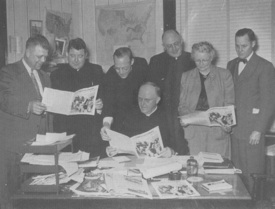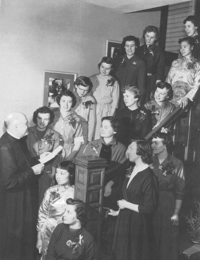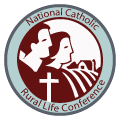Catholic Rural Life (CRL) has a rich history spanning over an entire century. The organization, originally called National Catholic Rural Life Conference (NCRLC), has spent decades dedicating hard work and prayer to promoting Catholic life in rural America.
1920s
The National Catholic Rural Life Conference was founded on November 11, 1923, the third day of a gathering of bishops, priests, and laity in St. Louis, Missouri. They shared common concerns about Catholic rural life and determined it was time to form an active organization.
Father Edwin V. O’Hara, then director of the National Catholic Welfare Conference’s Rural Life Bureau, was the spirit and energetic guide behind the National Catholic Rural Life Conference. Through his study of Catholic rural education, O’Hara saw that the rural Church was underserved in terms of priests, churches, hospitals and Catholic schools. He felt this was part of a pattern of overall neglect in which Church authorities gave little attention to the social, economic or religious problems of rural Catholics.
Throughout the latter half of the 1920s, NCRLC was primarily interested in religious education for rural Catholics and the challenge of anchoring Catholics to the land.
1930s
During the Great Depression, the economic plight of farmers occupied a great deal of attention of the plan, which asserted that the most pressing need of American agriculture is an increase in the price of farm products.
Catholic farmers gave qualified support to most of the programs of the New Deal. Their critical discussions questioned the capitalistic system with its end for money rather than serving human needs. They could see the devastating effects of an unfettered market system on the family during the Depression.
Despite the hard times, the 1930s and early 1940s were a hopeful period for the NCRLC. It was during this time that the Conference attracted more members than at any other time in its history. In addition, NCRLC started a network of diocesan rural life directors.
1940s
In 1940, Monsignor Luigi G. Ligutti became NCRLC’s first full-time executive director. One of his initial  actions was to establish a national office in Des Moines, Iowa. He purchased a large home at 3801 Grand Avenue; this remained NCRLC headquarters until 1979. (Later, the office relocated to a smaller house on the outskirts of Des Moines.)
actions was to establish a national office in Des Moines, Iowa. He purchased a large home at 3801 Grand Avenue; this remained NCRLC headquarters until 1979. (Later, the office relocated to a smaller house on the outskirts of Des Moines.)
By the time Ligutti resigned as executive director in 1959, he had become the most important spokesman for Catholic rural life. Many thought of him as the personal symbol of the Catholic rural life movement.
1950s
During this decade, NCRLC made an extensive effort to train and educate rural leaders at the diocesan and local levels. However, even with its considerable success, its message was not reaching the average Catholic farmer. Perhaps the Conference’s most successful method of reaching the rural laity was through its spiritual program of liturgical revival, retreats, and devotions. It developed its own Rural Life Prayerbook, stressed Rogation Day processions and blessings for fields and farm, and claimed St. Isidore as the official patron of farmers and NCRLC.
1960s
Reverend Edward O’Rourke of Peoria, Illinois, became the new executive director during this decade. He was a strong supporter of self-help projects to aid the poor; he also favored non-governmental over  government aid because he believed that governmental aid could suddenly end with a change of political parties.
government aid because he believed that governmental aid could suddenly end with a change of political parties.
He urged Catholics to join the Peace Corps and Papal Volunteers for Latin America. Land reform was one of the most important common denominators in social unrest throughout Third World countries. Earlier than most groups in the United States, NCRLC called attention to the need for land reform, mainly through the advocacy efforts of Ligutti and O’Rourke.
The growth of commodity exports in the 1960s led to intensive farming and irrigation use domestically. A natural consequence was soil erosion and the dropping of water tables in the aquifers of our nation. NCRLC heightened its efforts for responsible stewardship and greater care of natural resources. The Conference also exercised its leadership in bringing together growers and farm workers in California to discuss common problems.
1970s
Monsignor O’Rourke remained at the Conference until 1971, when he was appointed as Bishop of Peoria. Reverend John J. McRaith joined the Conference on January 1, 1972. He believed that NCRLC’s role  should be that of a “people changer” and not a “problem solver.” He shifted direction from O’Rourke’s emphasis on social and economic issues to focus on bringing the Christian Gospel to rural people. He worked at building up the NCRLC organization: more active diocesan directors and increasing membership.
should be that of a “people changer” and not a “problem solver.” He shifted direction from O’Rourke’s emphasis on social and economic issues to focus on bringing the Christian Gospel to rural people. He worked at building up the NCRLC organization: more active diocesan directors and increasing membership.
McRaith inspired many during those years not to give up on the rural church, insisting that food and land and other natural resources must be understood and treated as gifts from a loving Creator to meet the needs of all. In the mid-70s, the NCRLC Board of Directors adopted major policy statements on land use, energy and water.
Under the leadership of Bishop Maurice Dingman, NCRLC President from 1976-1979, NCRLC played a leading role in a three-year process called the Heartland Project. Under the direction of Dr. John Hart, the  pastoral letter “Strangers and Guests: Toward Community in the Heartland” was produced and was signed by Midwestern bishops of 44 dioceses on May 1, 1980.
pastoral letter “Strangers and Guests: Toward Community in the Heartland” was produced and was signed by Midwestern bishops of 44 dioceses on May 1, 1980.
Another major event for the NCRLC and Bishop Dingman was the most welcomed visit of Pope John Paul II to Living History Farms, Des Moines, Iowa on October 4, 1979. Ten NCRLC members from across the country were official representatives of the Conference at this great moment for rural life.
1980s
Greg Cusack, a former state legislator from Davenport, Iowa, was hired as executive director in 1981. During his tenure, NCRLC once again became active in impacting national food and agricultural policies. NCRLC testified at numerous legislative hearings and collaborated nationally with a number of rural life groups.
The early 1980s were rough times for farm families. Fluctuations in the farm economy and changing government policies took their toll. In the late 70s, farmers were told to expand. But by the early 80s, interest rates doubled and tripled; farm prices fell dramatically. Many farmers who were heavy in debt could not create cash flow. Farm foreclosures became common; farmers were severely stressed. Emotional hardships within families were added to the financial problems.
Rural life directors and NCRLC searched for ways to respond pastorally to farmers who were either in  danger of losing their farms or had already lost their farms. Members organized or became part of rallies on courthouse steps to stop foreclosures. Dioceses with an active rural life director or a commitment to a social concerns office developed one-on-one and family counseling programs. Some trained and developed peer counseling programs, retreat programs for farm couples, and support groups. Efforts were made to become more active in changing food and agriculture policies on both the state and national level that had been detrimental to farmers.
danger of losing their farms or had already lost their farms. Members organized or became part of rallies on courthouse steps to stop foreclosures. Dioceses with an active rural life director or a commitment to a social concerns office developed one-on-one and family counseling programs. Some trained and developed peer counseling programs, retreat programs for farm couples, and support groups. Efforts were made to become more active in changing food and agriculture policies on both the state and national level that had been detrimental to farmers.
In 1987, the Board hired Joseph Fitzgerald as the new executive director. His main charges were to strengthen grassroots efforts at diocesan levels, renew confidence among rural life directors, and to improve the structure and membership of the NCRLC Board.
1990s
Bishop William Skylstad of Spokane, Wash., was selected President of the Board of Directors, continuing the long tradition of episcopal leadership of the Conference. In 1994, the Board of NCRLC appointed Brother David Andrews, CSC as executive director. Brother Andrews brought fifteen years of experience in rural Church affairs, having taught in seminaries and in college courses in rural ministry; he was also former director of the Edwin O’Hara Institute for Rural Ministry Education and the Director of the Rural Ministry Collegium.
In one of his first acts as director, Brother Andrews re-launched the Catholic Rural Life magazine; he also produced other publications and spoke at events around the country. In 1997, the NCRLC Board of Directors called for a moratorium on large-scale livestock and poultry animal confinement facilities. As the new century began, Br. Andrews initiated NCRLC’s campaign, “Eating is a Moral Act”, which remains widely popular.
2000s
NCRLC began devoting significant time and resources to partnering with sustainable agriculture organizations and advocating for a new kind of Farm Bill beyond subsidies and commodity production. The Conference also began its work on environmental justice and climate change. NCRLC initiated its weekly electronic bulletin in 2002 and expanded its website as an information source for agriculture, food and the environment in light of Catholic social teachings.
At its peak during this time, NCRLC had eight full time staff and program areas including Grassroots Rural Ministry, Eating is a Moral Act, Religious Communities on the Land, Green Ribbon Campaign for Family Farms, and Rural Community Support Program. In June 2007 Brother David Andrews resigned from NCRLC.
In April 2008, James Ennis became the executive director. NCRLC launched a strategic planning process to guide the organization’s future. But in the fall of 2008, the nation faced a severe economic crisis and the beginning of a recession. Donations, contributions and grants dropped off; NCRLC was forced to operate on a greatly reduced budget.
A ray of light shone in October 2009 during the 30th Anniversary Celebration of Pope John Paul II’s historic visit to Iowa, which NCRLC hosted with the Diocese of Des Moines and Living History Farms. This was an opportunity to explore the role of the Catholic Church in agriculture and stewardship of the land for the common good.
2010 to Today
In 2010, NCRLC completed its strategic plan and is now carrying out new programs and activities. The organization rethought its programming, organizing its efforts into three distinct but inter-related Areas of Impact: Ethical Food and Agriculture, Rural Outreach and Ministry, and Stewardship of Creation.
During this time, NCRLC focused much of its effort on revitalizing the Catholic faith in rural communities, where the decline in priestly vocations had stretched the Church thin. NCRLC developed and implemented the Life in Christ Lay Leadership Program, an educational program that equips laymen and women in rural communities to lead spiritual formation programs in their parishes. Additionally, the Rural Ministry Practicum was launched on the campus of the University of St. Thomas, introducing the future priests of the Church in the countryside to the particular challenges and issues affecting rural communities.
 In November of 2013, in celebration of its 90th anniversary, The National Catholic Rural Life Conference decided to change its name to Catholic Rural Life (CRL) to better and more concisely reflect its mission.
In November of 2013, in celebration of its 90th anniversary, The National Catholic Rural Life Conference decided to change its name to Catholic Rural Life (CRL) to better and more concisely reflect its mission.
In the summer of 2014 CRL officially moved its headquarters to St. Paul, Minnesota.
In partnership with the Pontifical Council for Justice and Peace, CRL organized and hosted the Faith, Food & the Environment symposium in November of 2014. The event launched a broader project entitled The Vocation of the Agricultural Leader, which provides food and farm leaders with faith-based guidance in their life and work.
In the fall of 2016 the first edition of the Vocation of the Agricultural Leader was printed. CRL hosted workshops and presentations throughout the country on the project over the next two years. Then, in early 2018, CRL hosted a national conference on the document, bringing together over 100 leaders from agriculture, environmental studies, and religious communities to continue to gain insights and feedback on the project.
In 2019, CRL received a grant from the Lilly Endowment, Inc. to begin a new program, Thriving in Rural Ministry. The program is crafted to provide rural priests spiritual refreshment, rural ministry insights and support, individual leadership development, an expanded understanding of integral ecology, and fraternity with other priests serving rural communities.


